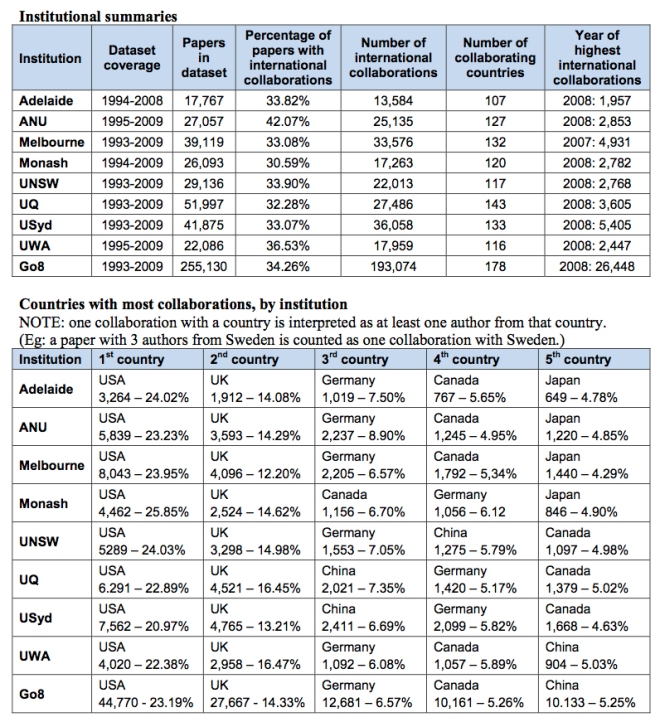How can we map out and make sense of the changing nature of research collaboration at a global scale? This is an issue many people and institutions are grappling with, with no easy solutions.
As noted in several previous GlobalHigherEd entries:
- From rhetoric to reality: unpacking the numbers and practices of global higher ed (5 November 2009)
- Are we witnessing a key moment in the reworking of the global higher education & research landscape? (12 October 2009)
- Higher education and collaboration in a global context: a new UK/US (Atlantic) perspective (29 June 2009)
- Europe’s new Strategic Framework for International Science and Technology Cooperation (15 November 2008)
- Globalizing research: forces, patterns, and collaborative practices (4 August 2008)
collaboration between researchers across space is clearly increasing, as well being increasingly sought after. From a sense that ‘global challenges’ like climate change demand collaboration, through to a sense that international collaboration generates higher impact (in a citation impact factor sense) output, there are signs that the pressure to facilitate collaboration will only increase.
At the same time, however, government ministries, funding councils, higher education associations, and universities themselves, are all having a challenging time making sense of the changing nature of research collaboration across space. Common questions include:
- Can this phenomenon be mapped out, and if so how and at what scales?
- Can baseline studies be created such that the effects of new international collaborative research programs can be measured?
- What happens to research practices and collaborative relations when universities join international consortia of universities?
One option is the use of bibliometric technologies to map out the changing nature of research collaboration across space. For example, the international linkages of the Australian Group of Eight (Go8) universities were mapped out (see some sample images below from the report Thomson ISI Go8 NCR dataset: Go8 International Collaborations, available via this University of Sydney website).
Other reports like Science-Metrix’s Scientific Collaboration between Canada and California: A Bibliometric Study (2008) used similar forms of data to understand collaboration between a country and a foreign state. I’ve also seen similar types of bibliometric-reliant reports while participating in discussions at Worldwide University Network (WUN) meetings, as well as on Thomson Reuters’ own website.
 Another option is to take an institutionally-specific perspective, though via the acquisition and analysis of a broader array of forms of data. This type of mapping can be developed via bibliometric technologies, researcher surveys, an analysis of travel expense claim data, an analysis of media ‘expertise’ data bases maintained by universities, and so on. This is an oft-desired form of analysis; one designed to feed into central repositories of knowledge (e.g., the University of Notre Dame is developing such a site, tentatively called Global ND). Yet such an approach is challenging and resource consuming to implement.
Another option is to take an institutionally-specific perspective, though via the acquisition and analysis of a broader array of forms of data. This type of mapping can be developed via bibliometric technologies, researcher surveys, an analysis of travel expense claim data, an analysis of media ‘expertise’ data bases maintained by universities, and so on. This is an oft-desired form of analysis; one designed to feed into central repositories of knowledge (e.g., the University of Notre Dame is developing such a site, tentatively called Global ND). Yet such an approach is challenging and resource consuming to implement.
In the end, for a range of reasons, bibliometrics are often the fallback tool to map out international collaboration. Bibliometrics have their important uses, of course, but they are not effective in capturing the research practices of all research scholars, especially those in the humanities and some arms of the social sciences.
Why? Well the main reason is different disciplines have different publishing practices, an issue funding councils like the Social Sciences and Humanities Research Council of Canada (SSHRC), or European agencies (including DFG, ESRC, AHRC, NWO, ANR and ESF) have recently been exploring. See for example, this March 2010 ESF report (Towards a Bibliometric Database for the Social Sciences and Humanities – A European Scoping Project), or Bibliometric Analysis of Research Supported by SSHRC: Design Study (March 2009) – a report for SSHRC by Science-Metrix.
If we go down the mapping route and rely too heavily upon bibliometrics, do we risk of letting the limitations of Thomson Reuters’ ISI Web of Knowledge, or the Scopus database, slowly and subtly create understandings of international collaboration that erase from view some very important researcher-to-researcher collaborations in the humanities, as well as some of the social sciences? Perhaps so, perhaps not!
In this context I am in search of some assistance.
If you or your colleagues have developed some insightful ways to map out international research collaboration patterns and trends in the social sciences and humanities, whatever the scale, please fill me in via <kolds@wisc.edu> or via the comments section below. Or one alternative response is to reject the whole idea of mapping, bibliometrics, and so on, and its associated managerialism. In any case, following a compilation of responses, and some additional research, I’ll share the findings via a follow-up entry in late August.
Thank you!
Kris Olds

